(完整word)人教版八年级英语下册unit4教学设计
- 格式:doc
- 大小:50.01 KB
- 文档页数:5
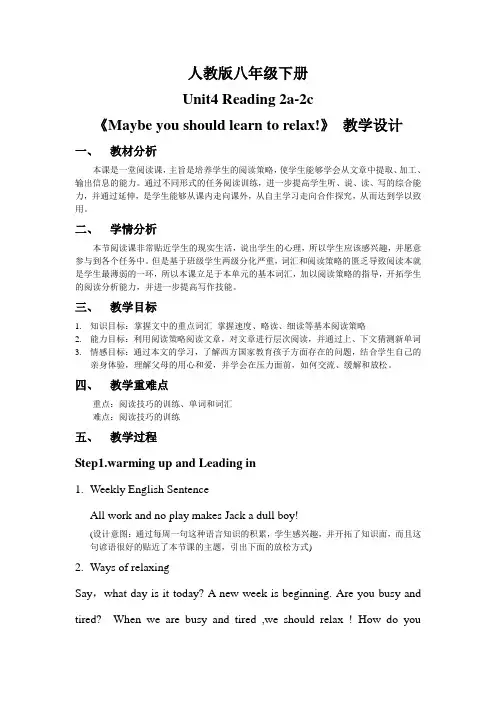
人教版八年级下册Unit4 Reading 2a-2c《Maybe you should learn to relax!》教学设计一、教材分析本课是一堂阅读课,主旨是培养学生的阅读策略,使学生能够学会从文章中提取、加工、输出信息的能力。
通过不同形式的任务阅读训练,进一步提高学生听、说、读、写的综合能力,并通过延伸,是学生能够从课内走向课外,从自主学习走向合作探究,从而达到学以致用。
二、学情分析本节阅读课非常贴近学生的现实生活,说出学生的心理,所以学生应该感兴趣,并愿意参与到各个任务中。
但是基于班级学生两级分化严重,词汇和阅读策略的匮乏导致阅读本就是学生最薄弱的一环,所以本课立足于本单元的基本词汇,加以阅读策略的指导,开拓学生的阅读分析能力,并进一步提高写作技能。
三、教学目标1.知识目标:掌握文中的重点词汇掌握速度、略读、细读等基本阅读策略2.能力目标:利用阅读策略阅读文章,对文章进行层次阅读,并通过上、下文猜测新单词3.情感目标:通过本文的学习,了解西方国家教育孩子方面存在的问题,结合学生自己的亲身体验,理解父母的用心和爱,并学会在压力面前,如何交流、缓解和放松。
四、教学重难点重点:阅读技巧的训练、单词和词汇难点:阅读技巧的训练五、教学过程Step1.warming up and Leading in1.Weekly English SentenceAll work and no play makes Jack a dull boy!(设计意图:通过每周一句这种语言知识的积累,学生感兴趣,并开拓了知识面,而且这句谚语很好的贴近了本节课的主题,引出下面的放松方式)2.Ways of relaxingSay,what day is it today? A new week is beginning. Are you busy and tired? When we are busy and tired ,we should relax ! How do yourelax?Show the pictures for the student, and say out the ways of each picture. Ask, What do you usually do after shool?(设计意图:通过图片的展示,提供多种放松方式,引出2a内容)Step2 Pre-readingAsk students to do activity 2a by themselves , the answers are vary. Then change the answers in pairs.Step3.While readingSay I know you’re very tired , you have too much homework to do ,you have to study for the tests, so you should learn to relax. Let’s look at activity 2b.1.Fast readingIntroduce the reading strategy and show the students how to do.1) Get the students to read the title, the 1st and the last sentence of each paragraph, then predict the main idea of the article.2) Try to answer the two questions in 2b to check if they understand the main idea.(设计意图:通过速度,使学生能找到问题的答案,了解文章大意)2.Skim reading1)Introduce this step for the students, then let them read the article andfind out the words on the screen2)Introduce the reading strategy in the book for the students, guidethem to guess the meanings of those words3)Get students to read the sentences in 2c, let them finish the activity bythemselves4)Check the answers together.(设计意图:通过略读,让学生快速的找到出示的单词,运用课本中使用上下文猜测词义的阅读策略猜测词义,并完成2c部分词义和单词匹配的活动)3.Scan readingIntroduce this step and show the students how can do.1)Let students read the 2nd paragraph and finish the two tasks2)Check the answers together.3)Get the students read the 3rd paragraph and finish the tasks.4)Check the answers together.5)Get the students to read the 4th paragraph and answers the questions.6)Find 4 student to say out their answers.(设计意图:细读每个段落,使学生在细读的过程中理解每个段落的内容,并在此基础上完成阅读任务。
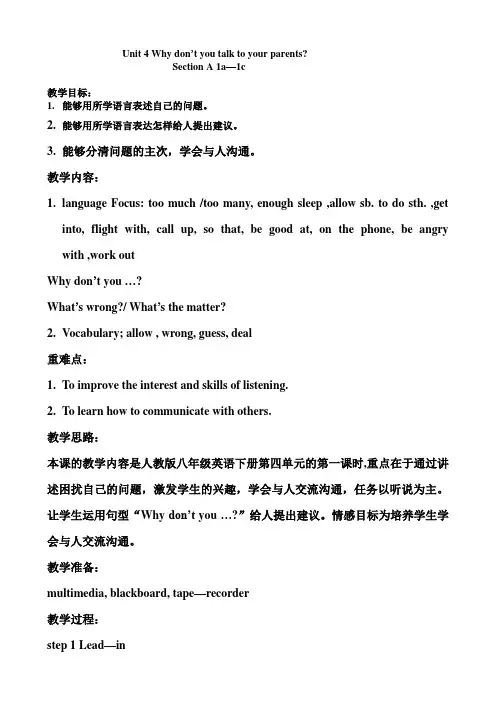
Unit 4 Why don’t you talk to your parents?Section A 1a—1c教学目标:1.能够用所学语言表述自己的问题。
2.能够用所学语言表达怎样给人提出建议。
3.能够分清问题的主次,学会与人沟通。
教学内容:nguage Focus: too much /too many, enough sleep ,allow sb. to do sth. ,getinto, flight with, call up, so that, be good at, on the phone, be angry with ,work outWhy don’t you …?What’s wrong?/ What’s the matter?2.Vocabulary; allow , wrong, guess, deal重难点:1.To improve the interest and skills of listening.2.To learn how to communicate with others.教学思路:本课的教学内容是人教版八年级英语下册第四单元的第一课时,重点在于通过讲述困扰自己的问题,激发学生的兴趣,学会与人交流沟通,任务以听说为主。
让学生运用句型“Why don’t you …?”给人提出建议。
情感目标为培养学生学会与人交流沟通。
教学准备:multimedia, blackboard, tape—recorder教学过程:step 1 Lead—inOne person was late for class.T ask her“Why are you late ?”S:Beause my alarm didn’t go off. T:For this reason,why don’t you check your alarm beforego to sleep? S:Yes, I’ll do it next time. T: Will, go back your seat.T:Ok, now look at the screen, and look at the boy in the picture.What’s wrong with him?S: He was unhappy.Beause he has too much homework to do.T:So we can tell him :Why don’t you talk to your parents?(为什么不和你的父母谈谈呢?) Now, let’s learn Unit4 Why don’t you talk to your parents?设计意图:让学生知道怎样说出自己的烦恼,如何给出建议。
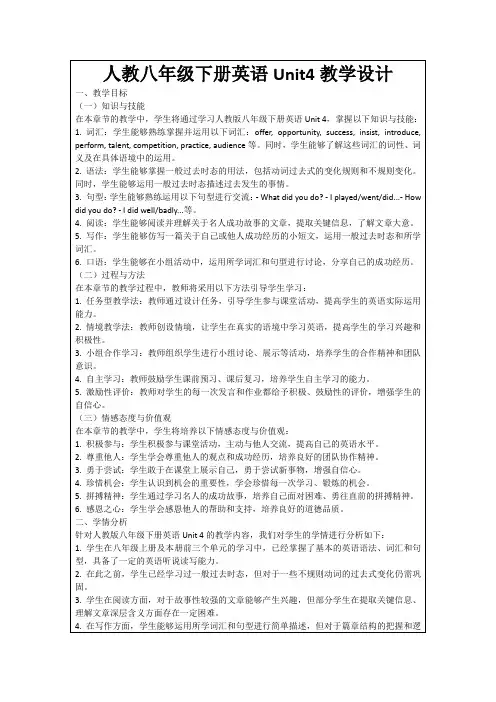

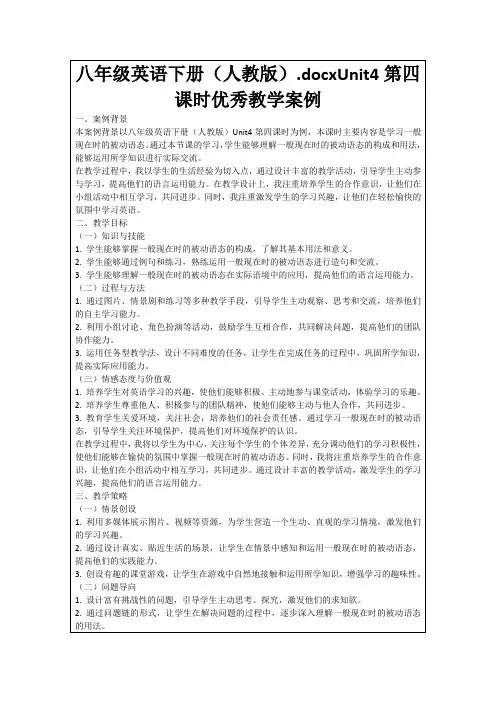
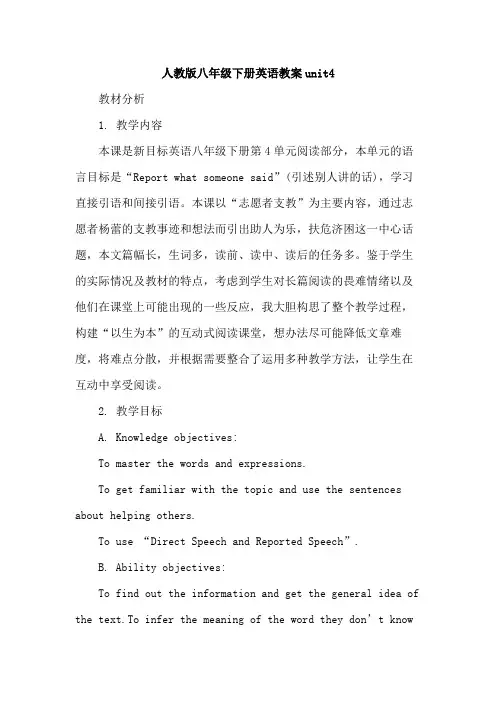
人教版八年级下册英语教案unit4教材分析1. 教学内容本课是新目标英语八年级下册第4单元阅读部分,本单元的语言目标是“Report what someone said”(引述别人讲的话),学习直接引语和间接引语。
本课以“志愿者支教”为主要内容,通过志愿者杨蕾的支教事迹和想法而引出助人为乐,扶危济困这一中心话题,本文篇幅长,生词多,读前、读中、读后的任务多。
鉴于学生的实际情况及教材的特点,考虑到学生对长篇阅读的畏难情绪以及他们在课堂上可能出现的一些反应,我大胆构思了整个教学过程,构建“以生为本”的互动式阅读课堂,想办法尽可能降低文章难度,将难点分散,并根据需要整合了运用多种教学方法,让学生在互动中享受阅读。
2. 教学目标A. Knowledge objectives:To master the words and expressions.To get familiar with the topic and use the sentences about helping others.To use “Direct Speech and Reported Speech”.B. Ability objectives:To find out the information and get the general idea of th e text.To infer the meaning of the word they don’t knowfrom the context.C. Affective objectives:Students are to realize the importance of helping others and they are encouraged to help others.Students’ team spirit will be improved by completing a certain task together.By understanding the life in rural areas, students are to realize how happy they are.3. 教学策略:(1)兴趣激发策略。
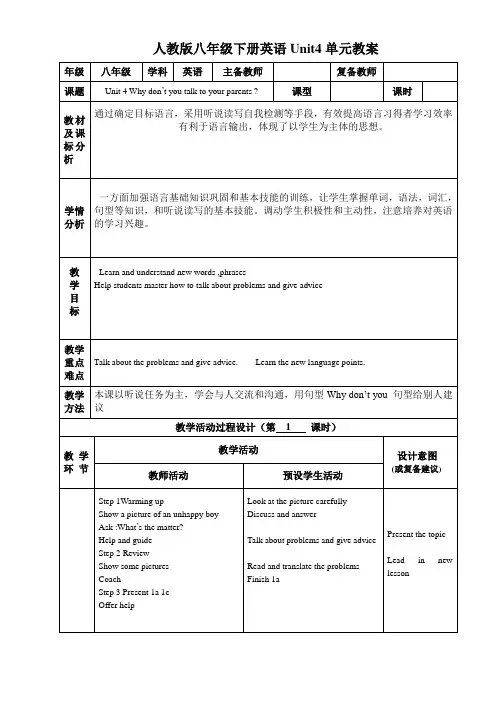
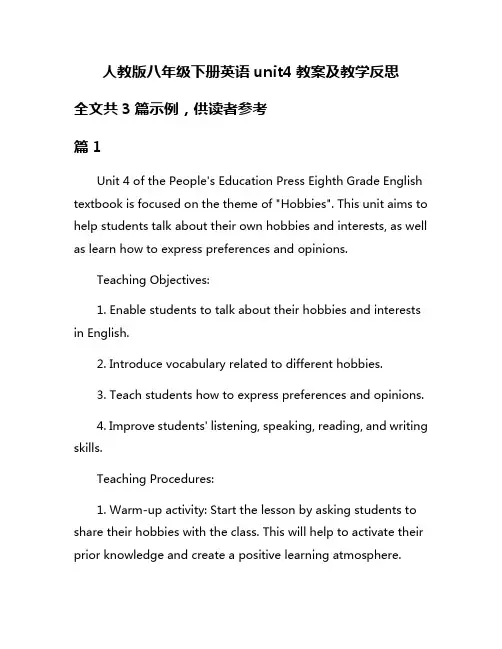
人教版八年级下册英语unit4教案及教学反思全文共3篇示例,供读者参考篇1Unit 4 of the People's Education Press Eighth Grade English textbook is focused on the theme of "Hobbies". This unit aims to help students talk about their own hobbies and interests, as well as learn how to express preferences and opinions.Teaching Objectives:1. Enable students to talk about their hobbies and interests in English.2. Introduce vocabulary related to different hobbies.3. Teach students how to express preferences and opinions.4. Improve students' listening, speaking, reading, and writing skills.Teaching Procedures:1. Warm-up activity: Start the lesson by asking students to share their hobbies with the class. This will help to activate their prior knowledge and create a positive learning atmosphere.2. Vocabulary introduction: Introduce key vocabulary related to hobbies, such as "painting", "cooking", "playing sports", etc. Use pictures, gestures, and realia to help students understand and remember the new words.3. Listening comprehension: Play a listening passage where people talk about their hobbies. Students listen and then answer comprehension questions to check their understanding.4. Speaking practice: Divide the class into pairs or groups and ask them to discuss their own hobbies, using the vocabulary they have learned. Encourage students to ask questions and share their opinions with each other.5. Reading activity: Give students a reading passage about different hobbies and ask them to identify key information, such as the benefits of each hobby and how to get started.6. Writing task: Ask students to write a short paragraph about their favorite hobby, describing why they enjoy it and how it makes them feel. Provide feedback on their writing to help improve their language skills.7. Role-play activity: Divide students into pairs and give them a role-play scenario where they discuss their preferencesfor different hobbies. This will help them practice expressing opinions and using the target vocabulary.8. Review and assessment: End the lesson with a review of key vocabulary and concepts covered in the unit. Administer a quiz or speaking activity to assess students' understanding and progress.Teaching Reflection:Overall, teaching Unit 4 on Hobbies was engaging and effective. The activities helped students practice speaking, listening, reading, and writing skills in a fun and interactive way. However, one area for improvement is to provide more opportunities for students to use the target language in real-life contexts. For example, incorporating project-based learning tasks where students create a hobby-themed presentation or video could further enhance their language proficiency.In conclusion, Unit 4 provided a valuable opportunity for students to explore their interests and hobbies in English. By incorporating a variety of activities and assessments, teachers can help students achieve the learning objectives and improve their English language skills.篇2Unit 4 of the People's Education Edition eighth grade English textbook covers the topic of "Wild Animals". In this unit, students will learn vocabulary related to wild animals, practice reading and listening skills through various texts, and improve their ability to describe animals and discuss their habitats.Lesson 1:- Warm-up: Start the lesson by asking students to name different wild animals they know.- Vocabulary: Introduce new vocabulary words related to wild animals such as lion, elephant, tiger, etc.- Reading: Read a short passage about different wild animals and ask students comprehension questions.- Listening: Play a recording of different animal sounds and ask students to match the sound with the correct animal.- Speaking: Have students describe their favorite wild animal and why they like it.Lesson 2:- Warm-up: Review the vocabulary words from the previous lesson by playing a matching game.- Reading: Read a longer passage about a safari trip and ask students to identify the animals mentioned in the text.- Grammar: Introduce comparatives and superlatives using examples related to wild animals (e.g. The elephant is bigger than the giraffe).- Speaking: Have students work in pairs to discuss which animal they think is the most interesting and why.Lesson 3:- Warm-up: Play a game of charades where students act out different wild animals for their classmates to guess.- Reading: Read a passage about endangered animals and discuss why it is important to protect them.- Writing: Have students write a short paragraph about what they can do to help protect endangered animals.- Speaking: Conduct a class debate on whether or not zoos are good for wild animals.Lesson 4:- Warm-up: Review the vocabulary and grammar concepts learned in the previous lessons through a quiz.- Project: Have students work in groups to create a poster about a specific wild animal, including information about its habitat, diet, and interesting facts.- Presentation: Have each group present their poster to the class and answer questions from their classmates.Teaching Reflection:Overall, the unit was engaging and interactive for students. The variety of activities helped to keep students interested and motivated throughout the lessons. The vocabulary and grammar concepts were presented in a clear and concise manner, allowing students to grasp the new material easily. The project at the end of the unit provided students with an opportunity to apply what they had learned and showcase their creativity. However, I would like to incorporate more opportunities for students to practice speaking and listening skills in future lessons to further develop their language proficiency.篇3Unit 4 of the eighth-grade textbook by People's Education Press focuses on the theme of "Wild animals". In this unit, students will learn about various wild animals and their habitats, as well as the importance of wildlife conservation.The unit is divided into several sections, including reading, listening, speaking, and writing tasks. The reading passages describe different wild animals such as lions, elephants, and pandas, providing students with essential information about these creatures. The listening activities help students improve their listening skills by practicing comprehension and understanding spoken English. Speaking tasks encourage students to express their opinions and share information about wild animals with their peers. Writing tasks require students to write short paragraphs or essays about their favorite kind of wild animal or the importance of wildlife conservation.To begin the unit, teachers can introduce the topic of wild animals by showing pictures or videos of different types of wildlife. This can generate interest and curiosity among students, prompting them to learn more about these fascinating creatures. Teachers can also engage students in group discussions or debates about wildlife conservation and the impact of human activities on the environment.During the reading and listening activities, teachers should provide support and guidance to students as they work through the text and audio materials. Encouraging students to ask questions, make predictions, and summarize key points can helpthem better comprehend the information presented. Teachers can also incorporate vocabulary-building exercises, such as word matching or crossword puzzles, to reinforce new words and concepts.For the speaking and writing tasks, teachers can encourage students to use creative expression and critical thinking skills. Providing opportunities for role-playing, storytelling, and collaborative writing can enhance students' language abilities and boost their confidence in using English. Teachers can also assign group projects or presentations that require students to research and present information about specific wild animals or conservation efforts.In conclusion, Unit 4 of the eighth-grade textbook by People's Education Press offers a comprehensive and engaging exploration of wild animals and wildlife conservation. By incorporating a variety of teaching strategies and activities, teachers can facilitate students' learning and language development in a meaningful and enjoyable way. Through active participation and interaction, students can deepen their understanding of the natural world and cultivate a sense of responsibility towards protecting our environment and its inhabitants.。
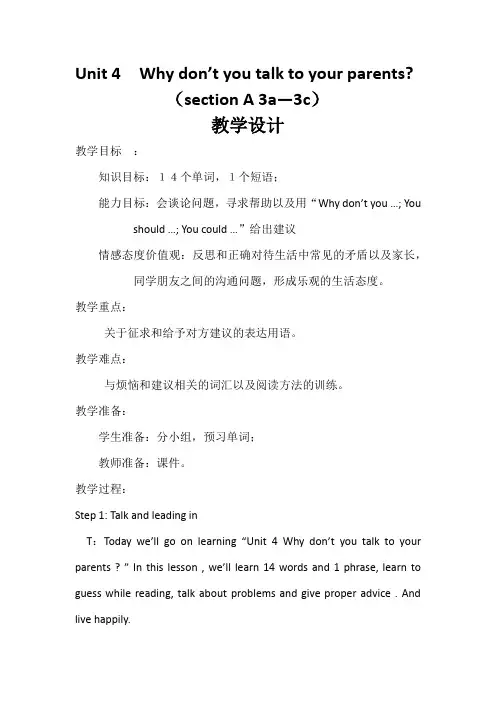
Unit 4 Why don’t you talk to your parents?(section A 3a—3c)教学设计教学目标:知识目标:14个单词,1个短语;能力目标:会谈论问题,寻求帮助以及用“Why don’t you …; You should …; You could …”给出建议情感态度价值观:反思和正确对待生活中常见的矛盾以及家长,同学朋友之间的沟通问题,形成乐观的生活态度。
教学重点:关于征求和给予对方建议的表达用语。
教学难点:与烦恼和建议相关的词汇以及阅读方法的训练。
教学准备:学生准备:分小组,预习单词;教师准备:课件。
教学过程:Step 1: Talk and leading inT:Today we’ll go on learning “Unit 4 Why don’t you talk to your parents ? ” In this lesson , we’ll learn 14 words and 1 phrase, learn to guess while reading, talk about problems and give proper advice . And live happily.过渡:T:Are you ready ?(Ss :Yes)(学生对problem 和advice有了一定的接触,所以直接导入。
口述目标,让学生有目的地进入本节课的学习。
)过渡: T: Now ,let’s play a game :The best memory (教师出示课件)Step 2: Play a game : The best memoryT: Open your books to page 27. Look through 3a’s orders , two letters’ beginning and end for 30 seconds. (30 seconds later) T: Close the books and answer the questions: (教师出示课件,学生回答):1. Where do you usually see the letters?2. Who has problems?3. Who is giving advice?(练习学生浏览的阅读方法,激起学生的学习兴趣,初步了解课文大意。
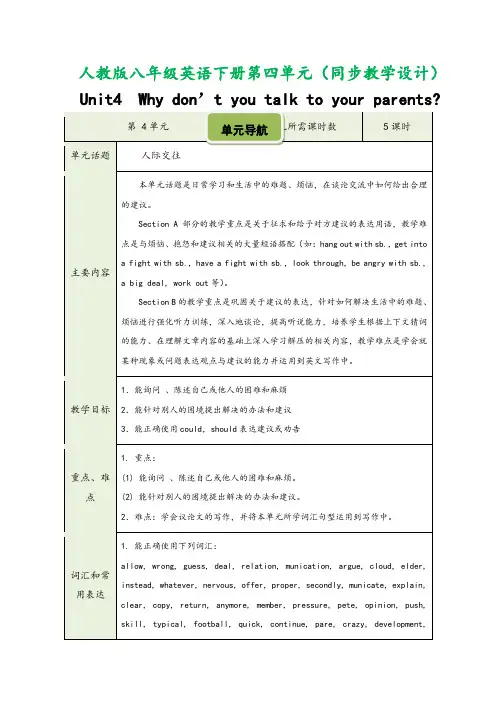
人教版八年级英语下册第四单元(同步教学设计)Unit4 Why don’t you talk to your parents?Unit 4 Why don’t you talk to your parents?Unit 4 Could you please clean your room?get along with—get on with He is getting on well with his newfriends.Step 4 Grammar focus1. Let Ss read the Grammar table and summarize.(1) 提出问题What’s wrong?What’s the matter? + with sb.What’s the problem/the trouble?(2) 给出建议情态动词should, should等should, shouldn’t常用来提出请求和建议could 也可用来给出建议。
表建议的句型:You should/could +v. Why don’t you + v.?Why not + v.? Could you please + v.?You’d better (not) + v.. Would you mind doing…?What about/How about + n./doing…?(3) 引导状语从句的连词although 即使,尽管 until 直到……为止so that 结果,因此2. Let Ss finish 4a and check the answers.Answers: 1. so that 2. Although 3. until 4. Although3. Give Ss several problems. Let Ss write one piece of advice for each problem. Then pare their advice with their partners’ and decide whether the advice is good or bad.Problems:(1)I’m very shy.(2)My sister and I fight all the time.Unit 4 Why don’t you talk to your parents?Unit 4 Why don’t you talk to your parents?Unit 4 Why don’t you talk to your parents?U nit 4 Why don’t you talk to your parents?老师在上课前,播放一段视频,向学生提出问题,通过对话引入本课时主题,引发学生共鸣,导入新课。
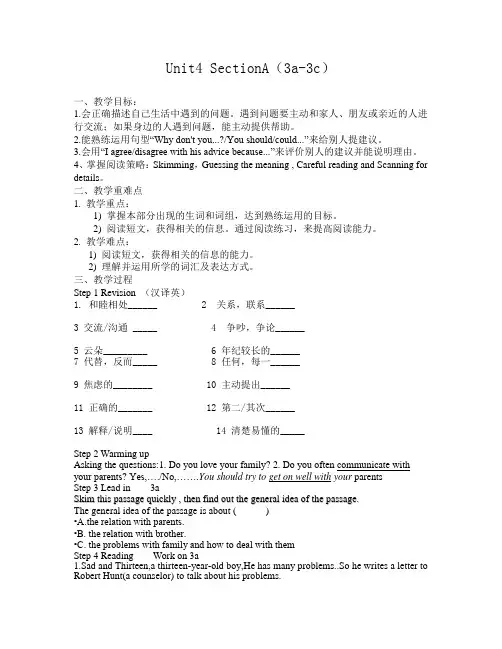
Unit4 SectionA(3a-3c)一、教学目标:1.会正确描述自己生活中遇到的问题。
遇到问题要主动和家人、朋友或亲近的人进行交流;如果身边的人遇到问题,能主动提供帮助。
2.能熟练运用句型“Why don't you...?/You should/could...”来给别人提建议。
3.会用“I agree/disagree with his advice because...”来评价别人的建议并能说明理由。
4、掌握阅读策略:Skimming,Guessing the meaning , Careful reading and Scanning for details。
二、教学重难点1. 教学重点:1) 掌握本部分出现的生词和词组,达到熟练运用的目标。
2) 阅读短文,获得相关的信息。
通过阅读练习,来提高阅读能力。
2. 教学难点:1) 阅读短文,获得相关的信息的能力。
2) 理解并运用所学的词汇及表达方式。
三、教学过程Step 1 Revision (汉译英)1. 和睦相处______ 2 关系,联系______3 交流/沟通 _____4 争吵,争论______5 云朵_________6 年纪较长的______7 代替,反而_____ 8 任何,每一______9 焦虑的________ 10 主动提出______11 正确的_______ 12 第二/其次______13 解释/说明____ 14 清楚易懂的_____Step 2 Warming upAsking the questions:1. Do you love your family? 2. Do you often communicate with your parents? Yes,…./No,…….You should try to get on well with your parentsStep 3 Lead in 3aS k i m t h i s p a s s a g e q u i c k l y,t h e n f i n d o u t t h e g e n e r a l i d e a o f t h e p a s s a g e.The general idea of the passage is about ( )•A.the relation with parents.•B. the relation with brother.•C. the problems with family and how to deal with themStep 4 Reading Work on 3a1.Sad and Thirteen,a thirteen-year-old boy,He has many problems..So he writes a letter to Robert Hunt(a counselor) to talk about his problems.2Read the article quickly and answer the questions.1).What’s Sad and Thirteen’s problem?2). How does he feel at home?3,Careful reading Letter 1 Find out the problems.1)Sa d and Thirteen’s main problem:2)About his parents:3)About his elder brother:4)About himself:4.Careful reading Letter 2Find out the problems.1)Sad and Thirteen’s main problem:Robert Hunt’s advice:2)About his parents:1.He should。
Unit 4 Why don’tyou talk to your parents?教材解本元的中心是人交往,与学生生活密有关,主要探今世中小学生所面的各种力和窘境,并些予合理的建。
通学本元,学生能、述自己或别人的困和麻,能人的窘境提出解决的法和建。
法部分主假如对于学生能正确使用情could, should 表达建或告,能正确使用 Why don ’tyou ⋯ ?句型表达建,能正确使用until ,so that,although 等。
通学本元,学生能反省生活中常的家庭矛盾以及与家、同学、朋友之的交流,并学会用正确的度待些。
在本元中学生能认识中西方家待孩子参加外活和外学班的度与做法,有益于学生学会位思虑,帮助他逐渐成立正确、极的生活度和价。
元目一、知与技术1. 掌握要点和短: until ,so that,although,look through ,big deal,work out , get on with , cut out, compare⋯ with , in one’s opinion2. 掌握要点句型: What ’s wrong? What ’s the matter? You could / should ⋯ Why don ’t you ⋯ ?3.培育听写各基本技术同着重培育在境中猜意的能力。
二、程与方法采纳直教课法、情形教课法、、角色表演等方法,学知,培育能力,养成好。
三、感情度与价通学,认识生活、学中常的矛盾和困,能合理表达自己的点和见解,人提出合理的建,逐渐成立正确、极的生活度和价。
教法航采纳直教课法,情形教课法,按照以学生主体的原。
学法航采纳自主学、小合作、分角色表演等学策略。
支配第1 : Section A 1a- 2d第2 : Section A 3a- 4c第3 : Section B 1a - 2e第4 : Section B 3a - Self Check教课设计1第 1 课时 Section A 1a- 2d教课目一、知与技术1.能掌握以下: allow , wrong , guess, deal, work out2.能掌握以下句型:①---W hat ’s wrong?---I’ m really tried because I studied until midnight last night.②You could give him a ticket to a ball game.③I think you should ask your parents for some money.④Why don ’ t you talk to him about it?3.能认识以下法:①能运用所学知和困、提出建并作出;②能依据方所提出的,出一些合理的建。
Unit 4 Why don’t you talk to your parents?Period 1 Section A 1a-2d【导学目标】1.Master the key words and sentences:(1) Key words:allow, wrong, guess, deal, write him a letter,talk about, look through, work out (2)Sentences:Why don’t you talk to your parents?My parents don’t allow me to hang out with my friends.Hope things work out..2.Learn to talk about abilities.Ⅱ. Teaching Key Points and Difficult Points1.Talk about problems..2.Give advice.【导学过程】Step1.Lead-in (3 minutes)Brain stormingT:Do you have any problem in your daily life?S:...T:How do you solve them? Give some advice.S:...Step 2.Presentation: look and say (5 minutes)1. Show some pictures and teach the new words and sentences.2.Let the students read the new words and remember them.3.Have a chant to consolidate the new words.Step 3.Activity 1a(5 minutes)1.Have students look at the pictures in Part 1a on the screen.Start by asking students to look at the problems.2. Pair work.Have you ever met any problems above?How do you solve them?Step 4. Activity 1c (4 minutes)Look at the problems in 1a and make conversations.Step 5.Activity 1b (3 minutes)Listen and circle the problems you hear in 1a.Step 6.Pair work (5 minutes)Choose one picture and make a conversation.A: What’s wrong?B: I’m really tired because I studied until midnight last night.A: Why don’t you go to sleep earlier this evening?Step 7.Activity 2a&2b (10 minutes)1.Get the students have a quick look at the instructions of these two activities,so they can know how to do them.2.Then play the recording the first time for the first time to fill in the blanks in 2a.3.Listen again. Why doesn’t Peter like his friend’s advice? Write the letters (a-e) next to the advice in 2a.4.Check the answers.Step 8. Activity 2c (3 minutes)Role-play a conversation between Peter and his friend.A: What’s the matter, Peter?B: I had a fight with my best friend. What should I do?A: Well, you should call him so that you can say you’re sorry.Step 9. Activity 2d (5 minutes)1. Listen to the tape and answer the questions:(1)What's wrong with Kim?(2)Does Dave give advice to Kim?What should Kim do?2.Read after the tape,pay attention to the pronunciation and intonation.3.Role play the conversation.4.Explain some language points.Step 10. Summary (2 minutes)Let the students think about what we have learned in the period.Step 11. Exercises (7 minutes)Let the students finish the exercises to consolidate what we have learned today.【探究归纳】1. too much和much too的区别:在too much中too修饰much, 表示程度, 它们修饰不可数名词;而在much too中, 是much修饰too, 在句中修饰形容词或副词, 意为“太,非常”。
人教版英语八年级下Unit4 单元备课He said I was hard-working.一、教材分析本单元主要的内容是在学生学习学了一般现在时、现在进行时、一般将来时、一般过去时、过去进行时以及简单的宾语从句的基础上,学习直接引语和间接引语的转换。
本单元主要有四部分构成:Section A,Section B,Self check 和 Reading .section A部分主要是学会转述电视剧中演员说的台词。
教师认真地讲解,这是本单元的重点内容。
Section B部分主要是对Section A加以延伸。
对 Section A中重要句型的用法加以延续,并学会写成绩报告单,并将成绩报告单给他人。
Self check部分主要是学生对自己学习结果的自我检测。
通过本部分的学习学生能够很好的了解到自己所学的情况。
更好的对自己进行查漏补缺。
Reading部分不仅仅是训练学生的阅读能力,而是训练学生的听说读写能力。
为了能够完成本单元的任务,就需要教师在实际教学过程中,要采用多种教学手段来完成教学任务。
如:通过情景对话、角色表演等形式,让学生能够把所学的知识灵活的运用到实际中。
二、教学目标(一)、知识目标1、直接引语和间接引语的转换。
2、掌握一些与之相关的词汇、短语、句型。
surprise,message,village,graduate,volunteer,decision,influence,border,danger,a rea,start,report,pass,suppose,copy,care for, get overHe said he was mad at Mary.She told me she would call me tomorrow.I’m good at speaking.I’m better at reading than listening.I can do better in math.It’s not right for you to copy others’ homework.(二)、能力目标1)依托本单元的语言素材提高学生听、说、读、写能力。